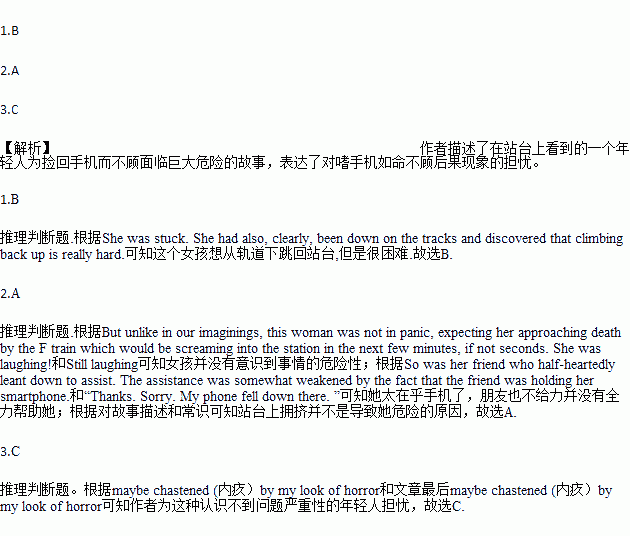题目内容
We’d arrived at Rockefeller Center station on the D train. As in many of New York’s underground stations, trains pull in at both sides of the platform. Or rather, they seem to erupt into the station first on one side, then on the other.
Abruptly, my wife stopped.
“Uh, what’s this?” she said.
I looked over her shoulder. There at our feet lay a young woman of about 20. She was on her stomach with the top half of her body on the platform, while her legs hung over the tracks kicking powerlessly.
She was stuck. She had also, clearly, been down on the tracks and discovered that climbing back up is really hard.
But unlike in our imaginings, this woman was not in panic, expecting her approaching death by the F train which would be screaming into the station in the next few minutes, if not seconds.
She was laughing! So was her friend who half-heartedly leant down to assist. The assistance was somewhat weakened by the fact that the friend was holding her smartphone. Was she hoping to capture this moment with a picture? Or composing a text?
It’s well known that people’s compulsive checking of their phones can be deadly. Among young people in America, texting is now the number one cause of car crashes. Maybe it’s also a leading cause of leaving friends to die when they fall in the river or on to the train tracks.
I stepped forward, leant out as far as I could, got hold of her leg somewhere near the knee and, together with her finally-engaged friend, dragged the young woman on to the platform.
And you can guess why she'd been on the tracks. Still laughing, but maybe chastened (内疚)by my look of horror she said, “Thanks. Sorry. My phone fell down there. ”
While I turned to hold my daughter’s hand and head upstairs, the young woman and her friend walked away. I wonder when she'll be scared.
1.What was the young woman doing on the edge of the platform?
A. Trying to get down on to the train tracks to pick up her phone.
B. Trying to get back on to the platform after jumping down.
C. Desperately waiting for someone to help her get back her phone.
D. Posing for her friend to capture a good picture with her smartphone.
2.Which of the following did the author think was NOT a cause of the young woman’s dangerous situation?
A. The station was too crowded.
B. She did not realize the danger.
C. She cared too much about her phone.
D. Her company didn't assist her whole-heartedly.
3.What was the author’s worry about people like this young woman?
A. They would cause damage to the underground system.
B. They knew too little about how to help others as well as themselves.
C. It would be too late when they understood how dangerous the situation is.
D. They would send misleading information to the public with their smartphones.


 5’ sheet of clear or slightly milky plastic, six feet of plastic tube, and a container— perhaps just a drinking cup — to catch the water. These pieces can be folded into a neat little pack and fastened on your belt.
5’ sheet of clear or slightly milky plastic, six feet of plastic tube, and a container— perhaps just a drinking cup — to catch the water. These pieces can be folded into a neat little pack and fastened on your belt. remember only two people can see you at the same time. Sorry about that, but you can see what would happen if we didn’t have these rules.
remember only two people can see you at the same time. Sorry about that, but you can see what would happen if we didn’t have these rules.